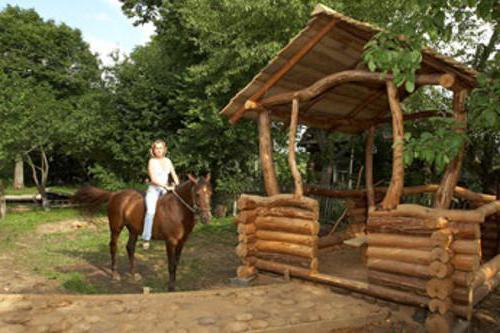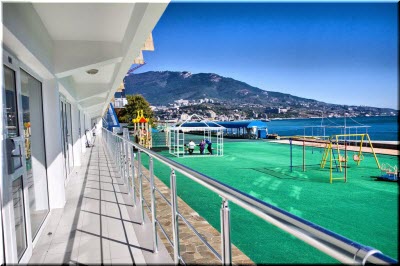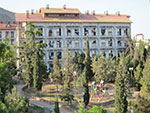Away from the city bustle.
How long have you had a desire to escape to nature? To a place as far from the hustle and bustle of the city. In the modern world there are few such places. One of them will be discussed below. 
Everyone has heard about the Republic of Karelia and its most popular attractions, but not everyone knows the place with the Finnish name Paanajärvi - a specially protected park in the very north of the republic, in the Louhsky district, where the population density is 0.57 people / km². There is no cellular connection in the park. Here, a person remains alone with nature, which gives a rather unusual sensation, which is complemented by the lack of electricity and running water, but first things first.
True connoisseurs of pristine wilderness 
To visit the park was opened in 1992. Until that time, an area of \u200b\u200b103 thousand hectares was closed and was under the supervision of border guards, which allowed to preserve the pristine beauty of these places. Today, the park accepts a limited number of visitors for several reasons. 
Firstly, the tourist area is equipped with a small number of residential houses, and the territory allocated for the campgrounds also has its limits. Thus, at the same time in the park there can be a limited number of guests. According to expert estimates, no more than 200 people per 5 thousand hectares. So it is necessary to reserve time and place in advance, and practice shows that it is better to make a choice 3-4 months before the trip. 
Secondly, not everyone is ready to spend their vacation away from civilization. The nearest grocery store is located in the village of Piaozersky, 70 km from the checkpoint, but, given the quality of the road, it takes 4 hours for one trip, so it’s better to bring a complete set of products for the entire stay. In addition, the assortment in the store is very modest. 
Thirdly, a poor-quality road leading to the park. After turning from the village of Louhi, a real test will begin for the suspension of your car. The road has its own characteristics, for example, in some sections there are tree trunks lying across, tall stones sticking out of the ground, and sometimes stumps. You need to be extremely careful in such areas, especially if you are not driving an SUV.
But these factors will not scare away a true connoisseur of pristine nature, since, according to the park’s employees, they have regular visitors who come here from year to year. Indeed, it is safe to say that this place is worth a second visit. 
One of the interesting features of the park: a rather large number of Finns are resting here, although they also have their own Oulanka park, bordering Paanajärvi. It would seem, why do the Finns come to Russia and live in such conditions? The fact is that the territory of the Oulanka park is too ennobled and the Finns, tired of civilization, want a closer relationship with nature. And although there are many wild places in the Russian outback, Paanajärvi is closest to the Finns. According to the staff of the park: “In Oulanka [from frequent touches] all the stones are polished.” 
The atmosphere of "autonomous life" 
Residential guest houses are quite cozy and pretty. They are log cabins with a capacity of 3 to 20 people. Inside each house there is a stove-potbelly stove. Bed linen is provided upon check-in at the park's visit center. Food is cooked at the stake, for which firewood must first be chopped. 
Kruglyaki are located in the woods near the houses - the park administration provides guests with the necessary amount of firewood and other equipment, including utensils. The water supply in the park is “natural”, as there are a great many rivers and rivulets in Karelia. They also did not deprive the territory of the park. So water for drinking and cooking can be taken from a neighboring river. Near each tourist camp there is equipped access to the river for water collection. 
With regard to cleanliness and hygiene, we also took care of this: each toilet house has its own toilet. There is also a bathhouse - either one per house or one per two houses. After you have brought water, chopped wood, prepared food and eaten, you can take the time to have plenty of fun. We list the most interesting sights.
Paanajärvi Lake 
The lake of the same name with a length of 21.5 km and a maximum width of 1.5 km (maximum depth - 128 m). A tourist path passes through the lake to the old village, from which only the foundation of the school and several logs of the water mill are preserved. The village consisted of several farms and in its heyday totaled about 700 inhabitants. She had her own police station, 3 schools, a post office, a hut for patients, several shops, a bank branch and ceased to exist in 1944. Now this place is interesting because it has a picturesque Mäntyukoski waterfall. 
For tourists, there are two ways to get to Mäntyukoski. The first, most interesting (and the only one before the opening of the tourist season) is boat rental and an independent trip. The second - on a common boat with a capacity of 20-30 people.
Of the 21.5 km of the lake, only 16 km are open for tourists. This is enough to inspect the waterfall, but then the official boat is not lucky for you. It is better not to study the rest of the lake on a boat, since you will not have enough fuel and at some point you will have to row the oars. It is worth mentioning that when you rent a boat yourself, you will be asked to sign papers on the briefing. After a short instruction on the features of engine control on a boat, you will be allowed to sail independently. If you do not return 8 hours after departure, the park staff will go in search of you. 
Not far from the waterfall there is another attraction - Red Rock, or Ruskeakallio (the effect of red rocks is achieved by stones overgrown with orange lichen). A trout route also runs through the lake. This fish from the salmon family belongs to the noble breeds and is listed in the Red Book. Finns who come to Paanajärvi are sure to try to catch at least one such fish. Their goal is simple - a memory photo. After this, the fish is usually released. Locals say catching trout is not so easy. 
After a rather difficult trip along the lake and a walk to the waterfall, you can rest and eat. Fire in the park is allowed to be planted only in strictly designated areas. They have everything you need for a halt: a woodcutter with firewood, an ax, an equipped fireplace, a gazebo with a table in case of rain.
Mount Nuorunen 
It is considered the highest in Karelia (576 meters). From the top a view of a significant part of Karelia and a thin “strip” of Finland opens. At the top there is a rich flora, and to climb it, you need to walk 21 km, and only one way! 
A steep climb begins only at the end of the path, but most of the route runs through swamps, swamps, streams and forests teeming with mosquitoes. 
Experienced travelers are advised to bring rubber boots with them, but in rubber boots it’s hard to walk such a distance, so you need to change shoes. Needless to say, there are much fewer guests on this route than visitors to more equipped parts of the park. Not everyone will agree to such a test. 
In winter, you can climb a mountain on a snowmobile - experienced staff will take you to the top with a breeze. 
But if you decide on an independent “feat”, then you should not go further than 5 meters from the path, otherwise it is likely to be easily lost. So narrow the path and so it merges with the monotonous landscape. Lonely travelers should be especially careful.
The park’s employees have a fresh mindset about a lost tourist from Moscow: a man decided to walk to the summit alone, and as a result he was found in a few days, but he was already in a less optimistic mood than before the trip. 
However, at the base of the mountain there is an equipped parking lot and a campground. It is suitable for those who decided to stretch their pleasure and walk for two days. 
There are several seids at the top, but this one is most pronounced. 
Kivakkakoski Waterfall 
Located on the river Olanga. It is a series of rapids stretching for a length of about 100 meters. With a total drop height of about 12 meters, Kivakkakoski is considered the largest unregulated waterfall in Karelia. 
The flow of bubbling water is so noisy that it can be heard for a couple of kilometers, and so powerful that a huge amount of small splashes soars above it in the form of a cloud, so that in sunny weather you can almost always see a rainbow over the waterfall. 
During spawning, trout rises against the course of the Olanga, so if you carefully peer into the streams of water, you can become a happy witness to the scene when a fish, emerging from a seething stream, tries to overcome the force of a waterfall. The energy of the water here is so powerful that even after a couple of hours of being on the shore, you absolutely do not want to leave here.
Mount Kivakka 
The third largest mountain in Karelia with a height of 499.5 meters. Translated from Finnish, its name means "Stone Woman". This is a place with a breathtaking view of Piaozero. The top of Kivakka is more accessible than the top of Mount Nuorunen. 
The path to the top is about 4.5 km and includes places for recreation. Kivakka is a part of most of the must-see tourist destinations. 
This is truly a peaceful place, which, according to the locals, has a “white” energy (unlike Mount Vottovaara, which the locals associate with dark forces). 
On Kivakka, as on other Karelian mountains, there are seids - huge boulders mounted on small pebble stones. 
Small pebbles are arranged in such a way that allows the main boulder to remain stable for many hundreds of years. 
The age of these structures is so great that now it is very difficult to determine their meaning and purpose. There is still no consensus on why all this was created. There is an assumption that the Sami (the ancient inhabitants of Karelia engaged in fishing and hunting) placed seids on the high shores of the seas and lakes so that they could be seen from afar. 
For the Sami, it was not the stone itself that mattered, but the deity living in it, helping in crafts. It was assumed that the souls of dead ancestors were instilled into the stones. Saims were sacrificed. As a rule, these were the tails or heads of fish. Women were not allowed into the seids, and men approached the stones on their knees. 
Stones that resembled a man were especially revered. For example, this one looks like an old woman ?! Perhaps, in honor of this old woman, the Finns nicknamed the mountain "Stone Woman". 
The surface of the mountain, like everything in Karelia, is covered with swamps. Marshes at the top of the mountain are called hanging. There are quite a few of them on the flat peaks of the local mountains. 
Nevertheless, some tourists come to these places from year to year for the sake of communicating with such “friends”. 
Having already driven a few tens of kilometers from the borders of the park, I suddenly realized that there was a pause in the passenger compartment, everyone was very impressed by what they saw, scrolling through those unfortunately short-lived moments of stay in the arms of a hospitable Karelian nature.
Many Krasnoyarsk residents note that the regional center has recently become less and less suitable for living. The crowding of buildings and people, noise, dust, gas, endless traffic jams - all this gradually negates the prestige and convenience of life in the city. Nevertheless, the townspeople are also not ready to settle somewhere on the outskirts, in villages and remote villages - work, study, developed social and entertainment infrastructure do not let Krasnoyarsk far from the city. Therefore, many people choose a “middle ground” for themselves - they buy housing in the suburbs of Krasnoyarsk - where it is normal with the environment, and there is a stone's throw to civilization.
Moreover, even if you initially do not have money to order turnkey construction in the company, a frame house can be built independently and in stages. The Karkas-Sibir company at its own factory in Krasnoyarsk produces so-called house kits — sets of wall panels, roof trusses, etc. Having acquired such a "designer", you can build a house with your own hands and in several stages. It will be a little longer, but cheaper. Detailed instructions, drawings and even an on-line consultant who can remotely consult by telephone are attached to the home-intellect.
The same thing with utility bills - there is a "horror story" that you can go broke on the contents of a country house. However, the company "Frame-Siberia" refute this myth. The advantage of low-rise construction is precisely that it is possible to apply modern energy-saving technologies and materials, thanks to which the cost of public services at home will be approximately equal to the cost of servicing a city apartment. "Many of our customers after the very first winter in our houses refused wood heating and switched to electric heating. So much of the house retains heat," company employees explain.
It often happens that tired of the hustle and bustle of megalopolises, I want to escape somewhere closer to nature. Guided by this idea, the Polish architect created a project for a country mansion located on the water surface of the lake. The black-and-white geometric facade fits quite harmoniously into the mountain landscape.

Polish practice architect 81.WAW.PL. Michal Novak ( Michal nowak) developed the concept of a suburban residential mansion called The Crown House. The sharp rays of the house really resemble a kind of futuristic crown, located on the water surface of the lake.

The architect calls his project a great example of how clear geometric lines of a building can be successfully combined with the natural landscape.


Access to the house can only be carried out on the platform on one side. The entrance to the garage is practically not visible, it merges with the flat surface of the wall. The area of \u200b\u200bthe entire plot is 250 square meters, 160 of which are in the house.

This mansion is under construction, the House is a space of 85 square meters, including a number of spheres, as it were, "penetrating" into the main volumes. Some geometric shapes replace others.



